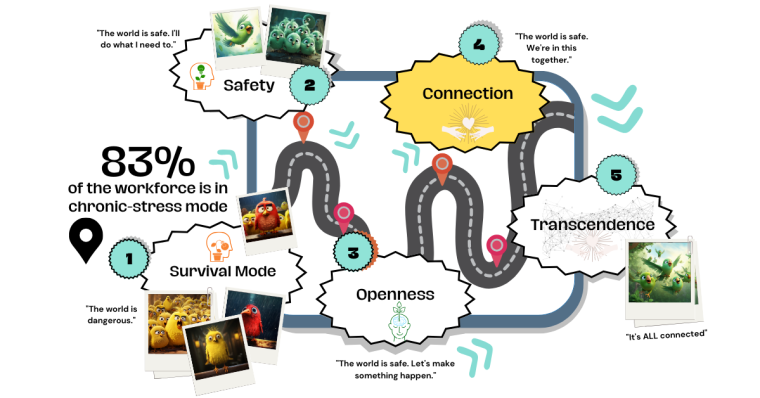Today, success is rarely achieved through solo efforts. Creating a thriving team culture means fostering a sense of interconnectedness amongst members. When employees feel valued for their unique contributions and supported by peers, motivation and performance soar more and more. But this level of psychological safety doesn’t happen overnight. It requires intention, consistency and vulnerability from managers. Through small but impactful actions, you can nurture interdependence and align values across your team. Simple ideas:
- Share polyvagal theory (eg 83% of US workers are in chronic-stress mode… Let your team know that you are here to help get them out of survival mode and into thriving. Then take action to do just that!)
- Share stories that highlight collective achievements
- Recognize cross-collaboration and diverse expertise
- Model vulnerability and interdependence
- Co-create team manifestos and shared vision
- Use inclusive language that reinforces shared goals

Visit The Higher Mind Leadership page for more resources.
The goal is to provide actionable steps to establish safety, building trust and belonging along the way as well. When a team feels tightly knit through a common purpose, they can tap into discretionary effort and resilience. Research shows that perceived interconnectedness has a positive influence on work satisfaction, engagement and performance.
This all starts with leadership modeling the behaviors first. By consistently nurturing interconnectivity, you help your team thrive as a unified entity empowered to take on challenges. Collaboration becomes the norm, not the exception. So get in touch with ways that you can champion interconnectedness at the team level. With small but consistent actions, you can reinforce the message that “we’re all in this together.” For example:
- Share stories during team meetings of times when team members came together to help each other meet a deadline or solve a problem. Highlight how everyone played a role in the collective success.
- When new projects kick off, have team members interview each other to learn about their unique skills and experiences that can contribute. Emphasize the diversity of strengths.
- Recognize cross-collaboration between team members, even if they are in different roles or departments. Praise the value of leveraging each other’s expertise.
- Model vulnerability and openness about your own challenges that required relying on the team’s support. Make it safe to acknowledge interdependence.
- Co-create “team manifestos” that highlight shared values like trust, diversity, and collaboration. Keep these visible.
- Celebrate milestones and achievements as a collective effort, emphasizing how each person’s role was essential. Avoid singling out any one contributor.
- Share research on psychological safety and trust, explaining how interconnectedness and vulnerability enhances team performance.
- Use inclusive, interconnected language like “we” and “us” when communicating about team goals and accomplishments.
The key is creating opportunities both large and small for people to share stories, recognize cross-collaboration, acknowledge interdependence, and feel valued for their unique contribution to the collective success.
Benefits:
- Increased engagement and satisfaction: When team members feel a sense of belonging and interconnectedness, they are more engaged and satisfied with their jobs (Smith et al., 2022)
- Improved collaboration: Highly interconnected teams collaborate more effectively by sharing knowledge and coordinating efforts (Mayo et al., 2022)
- Enhanced psychological safety: Interdependence promotes psychological safety by reducing fear of judgment or failure when taking risks (Frazier et al., 2017)
- Higher quality solutions: Leveraging diverse perspectives through cross-collaboration leads to better solutions (Hong & Page, 2004)
- Increased resiliency: Teams with strong interconnectedness and shared purpose are more resilient when facing challenges (Shin et al., 2012)
- Reduced turnover: Feelings of belonging and interconnectivity lower intention to leave the team or company (Hausknecht & Holwerda, 2013)
- Boosted motivation: When people feel their unique skills are valued, they are more intrinsically motivated to contribute (Deci et al., 2017)
- Improved performance: Highly interconnected teams experience less process losses, leading to better performance outcomes (De Jong et al., 2016)
Notes for PMP Candidates:
The PMP exam covers building an effective team environment as part of the People domain. Fostering interconnectedness aligns with PMI’s emphasis on servant leadership, collaboration, psychological safety, and ethics. According to the PMBOK guide, project managers should engage in practices like active listening, emotional intelligence, and leveraging diversity to build trust and cooperation. These allow the team to leverage individual strengths.
The PMP exam tests knowledge on improving team performance. Research shows psychological safety increases engagement, motivation, and outcomes. Interconnectedness enhances this by valuing diverse perspectives.
PMI’s values include accountability, collaboration, and responsibility. An interconnected team embodies this through collective ownership of goals. Team manifestos that highlight shared values can reinforce PMI’s member code of ethics.
In summary, PMP candidates should understand that interconnectedness facilitates knowledge sharing, coordinated effort, and purpose-driven work. It’s not just about individual competencies but synergizing as a team.
Anyone involved in project work is guided to be a diligent, respectful, and caring steward. A project manager’s role includes integrating diverse backgrounds into a cohesive, aligned delivery team. The PMP validates the ability to build an environment of engagement, transparency, and ethics. Interconnectedness is key to creating this high-performing culture.
